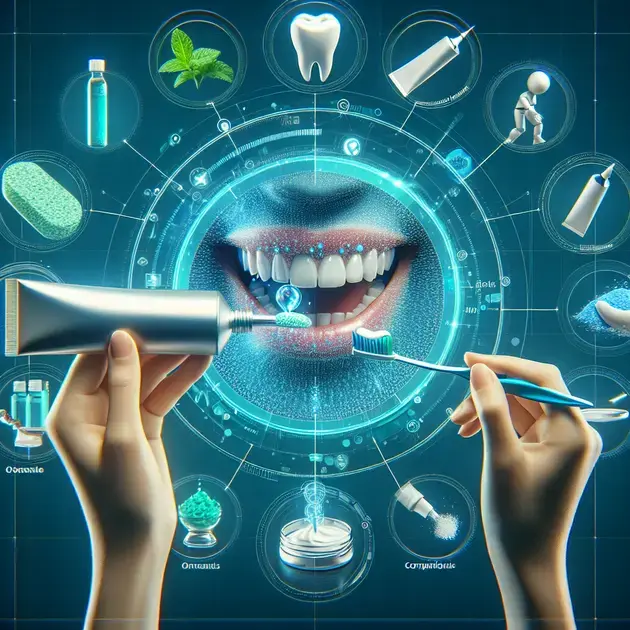When it comes to oral hygiene, choosing the right toothpaste is crucial for maintaining a healthy smile. In this ultimate guide, we will delve into why toothpaste is the best choice for your oral care routine.
With advancements in dental technology and research, toothpaste has evolved to offer not only cavity protection but also whitening benefits, tartar control, and fresh breath. This guide will explore the various types of toothpaste available and how to select the best one for your specific needs.

The Benefits of Toothpaste for Maintaining Oral Health
When it comes to maintaining proper oral health, toothpaste plays a crucial role. Not only does toothpaste help to clean teeth and freshen breath, but it also provides a range of benefits for overall oral hygiene. One of the key benefits of using toothpaste is its ability to remove plaque and prevent cavities. This is achieved through the abrasive action of the toothpaste, which helps to scrub away food particles and bacteria that can lead to tooth decay.
Additionally, many toothpaste products contain fluoride, a mineral that helps to strengthen tooth enamel and prevent cavities. Fluoride is essential for maintaining strong, healthy teeth and can significantly reduce the risk of decay. Some toothpaste formulas also include ingredients like baking soda or hydrogen peroxide, which can help to whiten teeth and remove surface stains.
To maximize the benefits of toothpaste for maintaining oral health, it is recommended to brush your teeth at least twice a day, especially after meals. Use a pea-sized amount of toothpaste and brush for at least two minutes, making sure to cover all surfaces of the teeth and gums. Regular dental check-ups and professional cleanings are also essential for ensuring optimal oral health.
Choosing the Right Toothpaste for Your Needs
With a wide variety of toothpaste products available on the market, choosing the right one for your needs can be overwhelming. To select the best toothpaste for your specific requirements, consider factors such as your age, oral health concerns, and personal preferences. If you have sensitive teeth, look for a toothpaste designed to reduce sensitivity and protect enamel.
For those who are prone to cavities, a fluoride-rich toothpaste is essential to strengthen enamel and prevent decay. If you are looking to whiten your teeth, opt for a toothpaste that contains whitening agents like baking soda or hydrogen peroxide. Be mindful of any allergies or sensitivities you may have to certain ingredients, such as mint or sulfates, and choose a toothpaste that is suitable for your needs.
To make an informed decision when choosing the right toothpaste, read reviews and recommendations from reputable sources such as the American Dental Association (ADA) website. Many dental care apps, like Colgate’s SmileView app, provide personalized recommendations based on your oral health needs and preferences.
Exploring the Evolution of Toothpaste Products
Over the years, toothpaste products have evolved significantly to meet the changing needs and preferences of consumers. From traditional toothpaste in tube form to innovative whitening toothpaste with advanced formulas, the market offers a wide range of options for maintaining oral hygiene. One notable advancement in toothpaste products is the introduction of natural and eco-friendly ingredients.
Many modern toothpaste brands now offer options that are free from artificial preservatives, colors, and flavors, catering to consumers who prefer more natural products. Additionally, toothpaste tablets and powders have gained popularity as convenient and sustainable alternatives to traditional toothpaste tubes. These compact and travel-friendly options help to reduce plastic waste and minimize the environmental impact.
To stay updated on the latest trends and innovations in toothpaste products, follow dental care blogs and websites like MouthHealthy.org. These resources provide valuable insights into new product launches, ingredient trends, and expert reviews to help you make informed choices for your oral health.

**
The Importance of Oral Hygiene Practices
**
Oral hygiene practices are essential for maintaining overall health and well-being. Proper oral care not only helps prevent dental issues such as cavities and gum disease but also plays a significant role in preventing systemic conditions like heart disease and diabetes. By establishing a regular oral hygiene routine, individuals can ensure the health of their teeth and gums for years to come.
One of the most important oral hygiene practices is regular brushing and flossing. Brushing at least twice a day with fluoride toothpaste helps remove plaque and bacteria from the teeth, preventing decay and bad breath. Flossing daily is also crucial for cleaning between the teeth and along the gumline, where a toothbrush cannot reach.
In addition to brushing and flossing, visiting the dentist regularly is key to maintaining good oral health. Dentists can detect early signs of dental problems and provide professional cleanings to remove stubborn plaque and tartar. They can also offer personalized advice on oral hygiene practices tailored to each individual’s needs.
Another important aspect of oral hygiene practices is following a healthy diet. Limiting sugary and acidic foods and drinks can help prevent tooth decay and erosion. Drinking plenty of water and eating a balanced diet rich in fruits, vegetables, and lean proteins can support overall oral health.
Overall, practicing good oral hygiene is crucial for preventing dental issues and maintaining a healthy smile. By taking the time to care for their teeth and gums, individuals can enjoy a lifetime of optimal oral health.
**
Innovative Ingredients in Modern Toothpaste
**
Modern toothpaste formulations are constantly evolving to include innovative ingredients that provide enhanced benefits for oral health. From whitening agents to sensitivity relief compounds, today’s toothpaste options offer a wide range of features to meet consumers’ diverse needs. Understanding the role of these ingredients can help individuals choose the best toothpaste for their oral care routines.
One of the most popular innovative ingredients in modern toothpaste is activated charcoal. Known for its ability to absorb impurities and toxins, activated charcoal can help remove surface stains from the teeth, leading to a brighter, whiter smile. Additionally, charcoal toothpaste is believed to have detoxifying properties that promote oral hygiene.
Another innovative ingredient found in modern toothpaste is fluoride. Fluoride is a mineral that helps strengthen tooth enamel and prevent decay. By incorporating fluoride into toothpaste formulations, manufacturers can offer added protection against cavities and maintain optimal oral health.
Some toothpaste brands also include probiotics in their formulations to support a healthy oral microbiome. Probiotics are beneficial bacteria that can help maintain a balanced oral environment, reducing the risk of harmful bacteria causing dental issues. By promoting a healthy bacterial balance, probiotics can contribute to improved oral hygiene.
Overall, the innovative ingredients in modern toothpaste play a crucial role in enhancing oral health outcomes. By choosing toothpaste formulations that contain beneficial ingredients like activated charcoal, fluoride, and probiotics, individuals can support their oral hygiene efforts and enjoy a healthier smile.
**
Effective Techniques for Proper Toothpaste Application
**
Proper toothpaste application is essential for maximizing the benefits of oral care products and ensuring optimal oral hygiene. By following effective techniques for toothpaste application, individuals can effectively remove plaque, protect against cavities, and maintain fresh breath. Understanding the best practices for using toothpaste can help individuals get the most out of their oral hygiene routines.
When applying toothpaste to the toothbrush, it is recommended to use a pea-sized amount for adults and a rice-sized amount for children. Excess toothpaste can lead to foaming and make it challenging to clean the teeth thoroughly. By using the right amount of toothpaste, individuals can ensure effective plaque removal without unnecessary waste.
It is important to brush the teeth for at least two minutes to ensure thorough cleaning. Using gentle circular motions, individuals should brush all surfaces of the teeth, including the front, back, and chewing surfaces. Paying attention to areas where plaque tends to accumulate, such as along the gumline and between the teeth, can help prevent cavities and gum disease.
After brushing, individuals should spit out the toothpaste rather than rinsing the mouth with water. This allows the fluoride in the toothpaste to remain on the teeth and continue providing protection against decay. By following this practice, individuals can maximize the benefits of fluoride and maintain strong, healthy enamel.
Lastly, individuals should brush their teeth at least twice a day, in the morning and before bed, to remove plaque and bacteria that have accumulated throughout the day. By establishing a consistent brushing routine and following effective techniques for toothpaste application, individuals can support their oral health and enjoy a fresh, clean mouth.
Conclusion
In conclusion, the importance of oral hygiene practices cannot be overstated. By prioritizing regular brushing, flossing, and dental check-ups, individuals can safeguard their overall health and well-being. These practices not only prevent common dental issues like cavities and gum disease but also contribute to the prevention of more serious systemic conditions such as heart disease and diabetes.
Furthermore, the incorporation of innovative ingredients in modern toothpaste formulations has revolutionized oral care. Ingredients like activated charcoal, fluoride, and probiotics offer enhanced benefits for maintaining optimal oral health. From whitening properties to strengthening enamel and promoting a healthy oral microbiome, these ingredients play a crucial role in supporting individuals’ oral hygiene efforts.
Lastly, effective techniques for proper toothpaste application are vital in maximizing the benefits of oral care products. By using the right amount of toothpaste, brushing for at least two minutes, and paying attention to all tooth surfaces, individuals can ensure thorough plaque removal and cavity protection. Following these techniques, along with establishing a consistent brushing routine, allows individuals to enjoy a fresh, clean mouth and long-term oral health benefits.